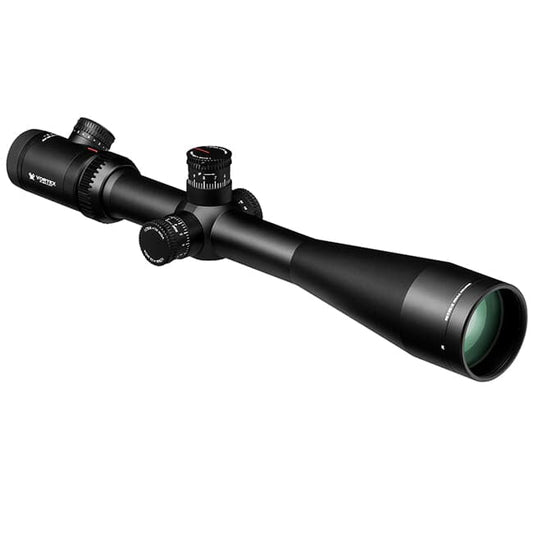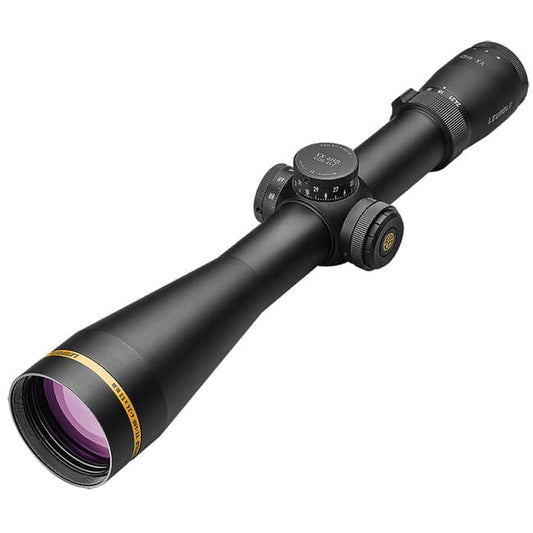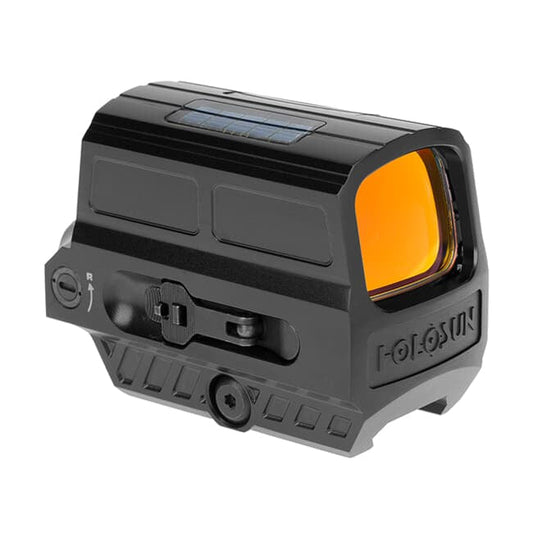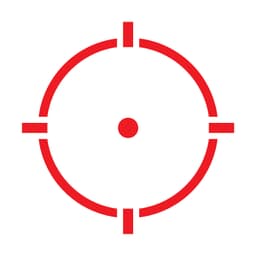Understanding Bullet Drop Compensation (BDC) Reticles in Riflescopes
The world of shooting and hunting is an exciting blend of precision, skill, and the right tools. And when it comes to hitting your target accurately, particularly at long distances, the choice of your riflescope and its reticle plays a crucial role.
That's where Bullet Drop Compensation (BDC) reticles come in, adding a whole new dimension to precision shooting. Let's dive into the world of BDC reticles, exploring their purpose, advantages, limitations, and so much more.
What are BDC Reticles?
In the realm of long-distance shooting, the bullet drop can be your biggest adversary. As bullets travel, they lose altitude due to gravity, resulting in what is termed as "bullet drop". BDC reticles are an innovative solution to this age-old problem.
They are a special type of riflescope reticle, equipped with additional markings below the central crosshair that help to accurately estimate and compensate for the bullet drop over various distances. They're like the built-in GPS on your scope, guiding your bullet to its target.
"Understanding and accounting for bullet drop is critical for accurate long-range shooting," says renowned shooting instructor and former Navy SEAL, Chris Sajnog. "And BDC reticles provide a practical solution by offering an easy-to-use system for compensating for bullet drop, eliminating the need for complex calculations or guesswork."
How Do BDC Reticles Work?
So, how does this magical tool work? BDC reticles operate on a simple yet effective principle of ballistics. They're calibrated for a specific cartridge and bullet type. Each marking or hash on the reticle corresponds to a specific bullet drop at a defined distance. Essentially, they're like cheat codes, helping you to accurately aim without having to manually adjust your scope every time.
The vertical series of circles, dots, or hash marks that you see below the central crosshair in a BDC reticle represents different distances. If your target is at a certain range and your reticle is calibrated for it, all you have to do is align the corresponding hash mark with your target, and voila! You've accounted for the bullet drop. The ease and simplicity of it almost feels like magic, doesn't it?
The Purpose of BDC Reticles
Estimating bullet drop can be a challenging task, especially in the field where variables are constantly changing. That's where BDC reticles come into play. They simplify the process of adjusting for bullet drop and make hitting your target more straightforward, allowing you to focus more on the shot itself than on the mathematics behind it.
BDC reticles are particularly advantageous in scenarios where the distance to the target varies significantly or changes rapidly. They allow shooters to quickly adapt to these changes and maintain high levels of accuracy. "Using a BDC reticle is akin to having a multilingual translator at a UN meeting. It swiftly bridges the gap between your intent and the actual output, giving you a clear advantage," says Mark Porter, a professional hunter and ballistics expert.
Advantages of BDC Reticles
BDC reticles offer a host of benefits that make them a popular choice among hunters and shooting enthusiasts:
- Improved Accuracy: When correctly calibrated and used, BDC reticles can significantly improve long-range shooting accuracy.
- Rapid Target Acquisition: They allow for quick adaptation to varying distances without the need to manually adjust the scope.
- Simplified Shooting Process: BDC reticles essentially simplify the complex mathematics of bullet drop compensation into a straightforward point-and-shoot process.
According to professional sharpshooter Janine White, "The advantage of a BDC reticle is that it enables you to keep your focus where it should be – on the target – rather than fiddling with knobs and calculations."
Limitations of BDC Reticles
While BDC reticles provide undeniable benefits, they're not without their limitations. They are designed to work with specific cartridges and bullet types, and changing your ammunition can cause the reticle's bullet drop indicators to become inaccurate. It's a bit like switching the key midway through a song; the tune is bound to go haywire!
Also, BDC reticles are often calibrated for specific environmental conditions. Changes in altitude, temperature, or humidity can impact the bullet's trajectory, thus affecting the accuracy of the BDC reticle. Think of it like trying to follow a recipe to the letter, but your oven's temperature is slightly off – the final dish might not turn out as expected.
Moreover, on variable power scopes, BDC reticles are typically accurate only at the highest magnification. This means that if you adjust your magnification, you'll need to recalibrate your aim points accordingly.
Selecting the Right BDC Reticle for Your Firearm
Choosing the right BDC reticle for your firearm is akin to choosing the right pair of running shoes – you need to find a match that's tailor-made for your specific needs. Consider your firearm type, your typical shooting distance, the specific ammunition you'll be using, and your own shooting skills.
Different cartridges and bullet types will require different BDC reticles. For instance, a .308 Winchester will have a different bullet drop compared to a .223 Remington at the same distance. Similarly, your shooting range will also play a role in the decision. If you're a hunter who frequently changes distances, you might want to opt for a BDC reticle with more range markers.
In the words of veteran firearms trainer, Jacob Collins, "Choosing the right BDC reticle for your firearm and shooting style is as critical as choosing the right arrows for your bow. The perfect match can significantly enhance your shooting accuracy and experience."
Understanding Bullet Drop and Ballistics
At the core of how BDC reticles work are the fundamental principles of bullet drop and ballistics. Bullet drop refers to the distance that a bullet falls due to gravity after it has been fired. Ballistics, on the other hand, is the science of the movement of projectiles. It takes into account factors like gravity, air resistance, and velocity to predict the bullet's trajectory.
Knowing your bullet drop and understanding the ballistics of your ammunition is key to making effective use of a BDC reticle. It's like knowing the rules of the game; only then can you effectively strategize and win.
Using BDC Reticles for Long-Range Shooting
When it comes to long-range shooting, BDC reticles are a valuable ally. They provide an efficient and reliable way to compensate for bullet drop at various distances, enabling you to make accurate shots without having to adjust your scope settings constantly.
But it's important to remember that BDC reticles aren't plug-and-play devices. They need to be calibrated and tested for your specific setup. This requires spending time at the range to ensure your bullet's actual drop aligns with the BDC reticle's markings at different distances. It's a bit like rehearsing your lines before the actual performance on stage.
Adjusting for Windage with BDC Reticles
Adjusting for windage – or the wind’s impact on your bullet – with a BDC reticle can be challenging but achievable with some understanding and practice. Here are some key points to remember:
Learn about your ammo: Different ammunition types behave differently in the wind. Lighter bullets can be more affected by wind than heavier ones. Understanding how your specific ammo behaves in different wind conditions is a crucial first step.
Understand wind speed and direction: Learn to assess wind conditions. Various tools can help, from handheld anemometers to observing environmental cues like the movement of leaves or grass.
Practice in varying conditions: Experience is a fantastic teacher. Practice shooting in different wind conditions to get a feel for how your bullet behaves and how your BDC reticle corresponds to that behavior.
Use the reticle’s marks: BDC reticles often include horizontal marks that can be used as reference points for windage adjustments.
Trial and error: Wind conditions can change rapidly, and predicting its effect on your shot isn't always straightforward. Don't be afraid to make educated guesses, see where your shot lands, and adjust accordingly.
Windage adjustments with BDC reticles can feel like a complex dance at times, but with understanding, practice, and a bit of patience, you'll be hitting your targets no matter the wind conditions. Just remember what seasoned shooter Laura Bishop said, "Adjusting for windage is as much an art as it is a science. Experience, intuition, and understanding your ammunition's ballistics are key."
Tips for Using BDC Reticles Effectively
Effectively using BDC reticles requires understanding, practice, and a few handy tips under your belt.
- Understand Your Ballistics: Get to know the ballistic profile of your ammunition - the bullet drop, velocity, and wind drift. This will help you anticipate how your bullet will behave in flight and how accurately your BDC reticle matches that behavior.
- Practice: Spend ample time at the shooting range, testing your BDC reticle at different ranges. Remember, the more familiar you are with your equipment, the better your performance will be.
- Stay Consistent: Stick with the same ammunition type that your BDC reticle is calibrated for to maintain accuracy.
- Know Your Ranges: Learn to accurately judge distances, or invest in a quality range finder. The effectiveness of a BDC reticle diminishes if you can't accurately estimate the distance to your target.
Remember what veteran shooter Jack Turner says, "A BDC reticle is only as good as the shooter behind it. Know your equipment, practice regularly, and stay patient."
BDC Reticles vs. Other Types of Reticles
BDC reticles are just one type of reticle available. Each type has its own advantages and uses, and choosing between them often depends on personal preference and the nature of your shooting.
For example, simple crosshair reticles offer a minimalist approach with a clean view, perfect for precise shooting at a single, known distance. Meanwhile, mil-dot reticles provide a series of reference points for both bullet drop and windage, making them useful for tactical shooting scenarios where distances and wind conditions can vary greatly.
However, BDC reticles stand out for their ability to provide fast, intuitive bullet drop compensation across a variety of ranges. They bridge the gap between the simplicity of crosshair reticles and the complexity of mil-dot reticles, offering a balance of ease-of-use and versatility.
Popular BDC Reticle Brands and Models
There are many top-notch brands out there offering high-quality BDC reticles. Some of the most popular ones include:
- Nikon: Known for their exceptional optics, Nikon offers a variety of scopes featuring their BDC reticle, designed to provide unique see-through ballistic circles for superior long-range shooting.
- Leupold: The Leupold VX-Freedom series riflescopes come with a custom dial system matched to your specific ballistic information, making bullet drop compensation simpler and more precise.
- Vortex: Vortex's Dead-Hold BDC reticle is a versatile option designed to minimize guesswork on holdover and windage corrections.
Each brand and model offers unique features and subtleties, so do your research to find the one that best fits your needs and preferences.
How to Zero Your BDC Reticle
Zeroing your BDC reticle is a critical step to ensure accuracy. Zeroing, or sighting in, is the process of aligning the sights (in this case, the reticle) so that the point of aim matches the point of impact at a specific distance.
Start by setting up a target at the distance you want to zero in. This is usually the distance corresponding to the center crosshair in your BDC reticle. Fire a group of shots, then assess where they hit relative to your aim point. Adjust the scope's windage and elevation settings accordingly to bring the bullet impacts in line with your point of aim.
Remember, zeroing is not a one-and-done process. You'll need to fire multiple groups, making small adjustments each time, until your point of aim and point of impact align consistently. It's like tuning a musical instrument - slight adjustments can make all the difference!
Maintaining and Caring for BDC Reticles
Maintaining your BDC reticle, much like any other piece of equipment, is paramount for its longevity and optimal performance. Here are some care tips:
- Clean Regularly: Use a soft, lint-free cloth or a brush to gently clean the lens. Special cleaning solutions can also be used for stubborn dirt.
- Avoid Rough Handling: Although most scopes are designed to withstand the recoil of a rifle, avoid unnecessary shock or rough handling to maintain the alignment and integrity of the reticle.
- Store Properly: When not in use, store your scope in a cool, dry place to protect it from moisture and temperature extremes.
Remember, a well-cared-for BDC reticle will serve you faithfully in countless hunting trips and shooting sessions!
Conclusion: Mastering BDC Reticles for Precision Long-Range Shooting
Mastering the use of BDC reticles can be a game-changer in your shooting performance, enabling quicker target acquisition, easier compensation for bullet drop, and ultimately, more accurate shots at varying distances. Like any tool, its effectiveness lies in the hands of its user. Understand it, calibrate it, take care of it, and most importantly, practice with it.
In the wise words of competitive shooter Janine White, "A BDC reticle is a tool, not a crutch. It's there to help you, but it can't replace skill, experience, and understanding. Practice, learn, and let the tool enhance your innate abilities, not define them." Master your BDC reticle, and you'll be well on your way to becoming a more precise and confident long-range shooter.





